320. After Canopus there were 18 right ascension days to Castor, when the Explorers reached Easter Island:
... [E:17] On the twenty-fifth day of the first month (Vaitu Nui), Ira and Makoi set sail; on the first day of June (Maro), the bow of Ira's canoe appeared on the distant horizon, came closer and closer on its course, and sailed along, and finally (one) could see the (new home) land ...
Playing with the numbers I have found it would be in good order to choose a time frame 41 precessional days before that of Bharani (*41).
| St John's Day (175) |
17 |
July 12 (193) |
88 |
Oct 9 (282) |
| Vaitu Potu 14 (134) |
He Maro 1 (152 = 193 - 41) |
Hora Iti 29 (241) |
| CANOPUS (93 = 175 - 82) |
CASTOR (111 = 152 - 41) |
SPICA (200) |
|
108 days |
|
Polygon: |
n |
A |
A / n |
|
|
triangle |
3 |
180° |
60° |
120 = 2 * 60 |
|
rectangle |
4 |
360° |
90° |
270 = 3 * 90 |
|
pentagon |
5 |
540° |
108° |
432 = 4 * 108 |
|
hexagon |
6 |
720° |
120° |
600 = 5 * 120 |
|
... On the last day, they issue forth to battle in martial array. Says Grimnismal (23): 'Five hundred gates and forty more - are in the mighty building of Walhalla - eight hundred 'Einherier' come out of each one gate - on the time they go out on defence against the Wolf.' That makes 432,000 in all, a number of significance from of old. This number must have had a very ancient meaning, for it is also the number of syllables in the Rigveda. But it goes back to the basic figure 10,800, the number of stanzas in the Rigveda (40 syllables to a stanza) which, together with 108, occurs insistently in Indian tradition, 10,800 is also the number which has been given by Heraclitus for the duration of the Aiōn, according to Censorinus (De die natali, 18), whereas Berossos made the Babylonian Great Year to last 432,000 years. Again, 10,800 is the number of bricks of the Indian fire-altar (Agnicayana) ...
Shall one add Angkor to the list? It has five gates, and to each of them leads a road, bridging over that water ditch which surrounds the whole place. Each of these roads is bordered by a row of huge stone figures, 108 per avenue, 54 on each side, altogether 540 statues of Deva and Asura, and each row carries a huge Naga serpent with nine heads. Only, they do not 'carry' that serpent, they are shown to 'pull' it, which indicates that these 540 statues are churning the Milky Ocean, represented (poorly, indeed) by the water ditch, using Mount Mandara as a churning staff, and Vasuki, the prince of the Nagas, as their drilling rope ...
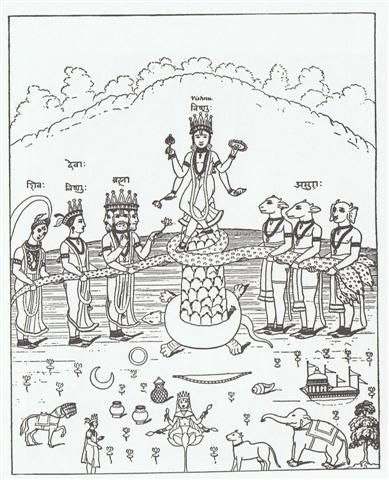
The 'incomparably mighty churn' of the Sea of Milk, as described in the Mahabharata and Ramayana. The heads of the deities on the right are the Asura, with unmistakable 'Typhonian' characteristics. They stand for the same power as the Titans, the Turanians, and the people of Untamo, is short, the 'family' of the bad uncle, among whom Seth is the oldest representative, pitted against Horus, the avenger of his father Osiris ...
The time frame which was 41 precessional days earlier than that of Bharani (*41) was that of the 3 great stone (Tau-toru) pyramids (corresponding to Tui in Orion):
.jpg)
|
APRIL 5 |
6 (396 - 300) |
7 |
 |
 |
 |
|
Ga1-15 |
Ga1-16 |
Ga1-17 |
|
λ Aurigae (79.0), λ Leporis
(79.6), ρ Aurigae (79.7)
ARCTURUS (α Bootis)
|
Shur-narkabti-sha-iltanu-5
(Star in the Bull towards
the north)
σ Aurigae (80.4),
BELLATRIX = γ Orionis, SAIF
AL JABBAR = η Orionis
(80.7),
ELNATH
= β Tauri
(80.9) |
ψ Orionis (81.1),
NIHAL = β Leporis
(81.7) |
|
June 8 |
9 (80 + 80) |
10 (161) |
|
... Midsummer is the
flowering season of the oak,
which is the tree of
endurance and triumph, and
like the ash is said to
'court the lightning flash'.
Its roots are believed to
extend as deep underground
as its branches rise in the
air - Virgil mentions this -
which makes it emblematic of
a god whose law runs both in
Heaven and in the Underworld
... The month, which takes
its name from Juppiter the
oak-god, begins on June 10th
and ends of July 7th. Midway
comes St. John's Day, June
24th, the day on which the
oak-king was sacrificially
burned alive. The Celtic
year was divided into two
halves with the second half
beginning in July,
apparently after a seven-day
wake, or funeral feast, in
the oak-king's honour
... |
|
°June 4 (*75) |
5 (156) |
6 |
|
'May 12 |
13 |
14 (*54) |
|
"April 28 |
Te Vaitu Nui
29 |
30 (*40) |
|
CLOSE TO THE FULL MOON: |
|
OCT 5 |
6 (200 + 79) |
7 (*200) |
|
ξ Ophiuchi (262.2), θ
Ophiuchi, ν Serpentis, ζ, ι
Apodis (262.4), ι Arae
(262.8), ρ Herculis (262.9) |
β, γ Arae (263.3), κ Arae
(263.5), σ Ophiuchi (263.6) |
LESATH = ν
Scorpii,
δ Arae (264.7),
CHOO = α Arae
(264.9) |
| Oct 9 (282) |
46 |
Nov 25 (329) |
14 |
Dec 10 (*264) |
| Hora Iti 29 (241) |
Tangaroa Uri 15 (288) |
30 (262 + 41) |
| SPICA (200 = 241 - 41) |
ANTARES (288 - 41) |
LESATH (262) |
| SPICA (159 = 200 - 41) |
ANTARES (288 - 82) |
LESATH (262 - 41) |
| 48 |
15 |
| 9 weeks |
|
|
Dec 8 |
9 |
10 (*264 = *81 + 183) |
|
°Dec 4 |
5 |
6 (*260) |
|
'Nov 11 |
12 (*236) |
13 |
|
"Oct 28 |
Tangaroa Uri
29 (*222) |
30 (303 = 79 + 32 weeks) |
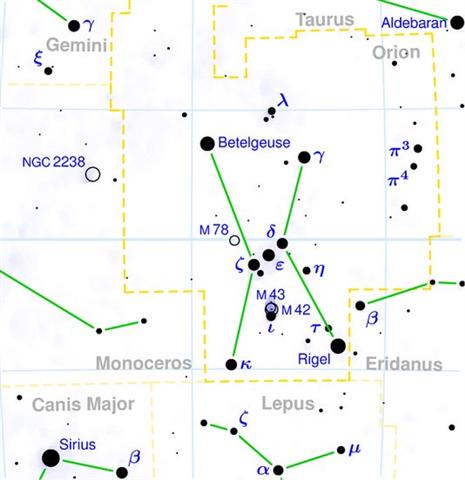
|
APRIL 8 |
9 (*19) |
10 (100) |
 |
 |
 |
|
Ga1-18 → 472 / 4 |
Ga1-19 |
Ga1-20 |
|
PYRAMID OF
KHUFU
MINTAKA (Belt) = δ
Orionis,
υ Orionis (82.4), χ
Aurigae (82.5), ε
Columbae (82.6) |
PYRAMID OF KHAFRE
Al Hak'ah-3 (White Spot)
/
Mrigashīrsha-5 (Stag's
Head) /
Turtle Head-20 (Monkey)
/
Mas-tab-ba-tur-tur
(Little Twins)
ARNEB = α Leporis, Crab
Nebula = M1 Tauri
(83.0,
φą Orionis
(83.1),
HEKA = λ Orionis,
Orion Nebula = M42
(83.2),
φ˛ Orionis
(83.6),
ALNILAM (String of
Pearls) = ε Orionis
(83.7) |
PYRAMID OF
MENKAURE
Three Stars-21
/
Shur-narkabti-sha-shūtū-6
(Star in the Bull
towards the south) /
ANA-IVA-9 (Pillar of
exit)
HEAVENLY GATE = ζ Tauri,
ν Columbae (84.0), ω
Orionis
(84.2),
ALNITAK (Girdle) = ζ
Orionis,
PHAKT (Phaet) = α
Columbae
(84.7) |
|
June 11 (*41 + *41) |
12 (163) |
13 |
|
°June 7 (*78 = *41 + *
37) |
8 (159) |
9 |
|
'May 15 (500) |
16 (136) |
17 (*57 = *84 - *27) |
|
"May 1 (*41)
|
2 (122) |
Vaitu Potu
3 |
| CLOSE TO THE FULL MOON: |
|
OCT 8 |
9 (*202) |
10 |
|
Al Shaula-17
ALWAID (Mother Camels)
=
β Draconis, MAASYM
(Wrist) = λ Herculis
(265.1),
SHAULA (Sting) = λ
Scorpii
(265.3),
KUMA = ν Draconis
(265.6), σ Arae (265.9)
HAMAL (α Arietis)
|
RAS ALHAGUE = α Ophiuchi
(266.1), SARGAS = θ
Scorpii (266.3), μ
Ophiuchi, π Arae
(266.5),
NAN HAE (Southern Sea) =
ξ Serpentis
(266.6), AL
DHĪLI (The Wolf) = ω
Draconis, ι
Herculis (266.7) |
λ Arae (267.1),
GIRTAB (Seizer) = κ
Scorpii, ο
Serpentis (267.6),
DSIBAN (Wolf Pair) = ψ
Draconis (267.9) |
|
Dec 11 (345) |
12 |
13 (LUCIA) |
|
°Dec 7 (341) |
8 |
9 (*263) |
|
'Nov 14 (318) |
15 |
16 (*240) |
|
"Oct 31 (304) |
"Nov 1 (*225) |
Ko Ruti
2 |
 |
There was a
string of pearls at the Sun when
the Full Moon was in "November 1
(Ko Ruti 1).
|
Tui.
1. To sew
mats, to make strings.
E-tahi tuitui reipá i
Te Pei, ekó rava'a
e-varu kaukau;
i-garo ai i Hiva, i te
kaiga, a necklace of
mother-of-pearl is on
te Pei, few will
find it (lit: eight
groups of people); it
has remained in Hiva,
in our homeland. 2. The
three stars of Orion's
Belt. Vanaga. |
... He picked up two stone figures (moai
maea) and two mother-of-pearl
necklaces (tuitui reipa).
The name of the first stone figure
was Apina Iti, and the second
one was Rapa Kura. Ira
took the figures and the ornaments,
went on, and came to Apina Iti.
He dug a pit, let the figure slide
down into the pit, and covered it up
with pebbles (kirikiri).
The head remained completely free (?
he puoko i hakapaka). He put
the necklace around the neck of the
figure and called the place 'Apina
Iti A Rapa Kura'. Ira
gave the stone figure the name 'Hinariru',
the name of the master, (son) of
Tuu Hokorua, who had given the
figure to Ira.
He turned around, went on, and
entered the cave Pu Pakakina
and remained there. All the young
men arrived and settled down
(to sleep) ...
|
Kaukau.
1.
Horizontal poles of a frame
(of a hare paega, or
a paina statue):
he-hakatu'u te tama o te
paina, he-kaukau, they
erect the vertical poles of
the paina then they
lay upon them the horizontal
ones. 2. Group of people:
e-tahi tuitui reipá i Te
Pei, ekó rava'a e-varu
kaukau; i-garo ai i
Hiva, i te kaiga, a
necklace of mother-of-pearl
is on te Pei, few
will find it (lit: eight
groups of people); it has
remained in Hiva, in
our homeland. 3. To go
through, to pass through in
unison; he-hogi-mai te
űka i te e'eo o te pua
kaukau-á i roto ite hare,
the girl smelt the
fragrance of the pua
wafting inside the house. 4.
Newborn baby's first hand
and feet movements (kaukau
or kau). The
five stages of a baby's
development are: kaukau,
puepe, tahuri, totoro,
mahaga. Puepue =
said of a newborn baby when,
a few weeks old, it begins
to distinguish people and
objects: ku-puepue-á te
poki. Tahuri = of
a new-born baby, to move
from side to side:
ku-tahuri-á te poki.
Totoro = to crawl; ki
totoro te poki, when the
baby crawls. Mahaga =
baby when able to stand by
itself. Vanaga. |
A leap down to the
ancient time 41
precessional days before the time of
rongorongo - viz. down to the female Bharani
(Yoni) star

|
ARIES: |
|
1 |
Ashvini |
β and γ Arietis |
Horse's head |
April 17 (107) |
|
wife of the Ashvins |
Sheratan and Mesarthim |
|
2 |
Bharani |
35, 39, and 41 Arietis |
Yoni, the female organ
of reproduction |
May 1 (121) |
|
the bearer |
Musca Borealis |
- could have been perceived
as a 'recycle' of an earlier such
precessional leap frome there and down to the
time of the male Khufu pyramid (male
because a Belt -
Mintaka - is a male sign),
and if so then there ought to have been another
similar change of sex
at Heka (because of the
following female star Girdle,
Alnitak).
... When this tremendous task had
been accomplished Atea took a
third husband, Fa'a-hotu,
Make Fruitful. Then occurred a
curious event. Whether Atea
had wearied of bringing forth
offspring we are not told, but
certain it is that Atea and
her husband Fa'a-hotu
exchanged sexes. Then the [male]
eyes of Atea glanced down at
those of his wife Hotu and
they begat Ru. It was this
Ru who explored the whole earth
and divided it into north, south,
east, and west
...
... The Heka triplet is where we
otherwise would have expected to see
a bright single star representing
Orion's head (when looking from a
location in the northern hemisphere)
...
λ
and the two stars phi furnish
an easy refutation of the popular
error as to the apparent magnitude
of the moon's disc, Colas writing of
this in the Celestial Handbook
of 1892: In looking at this triangle
nobody would think that the moon
could be inserted in it; but as the
distance from
λ
to
φą
is 27', and the distance from
φą
to
φ˛
is 33', it is a positive fact; the
moon's mean apparent diameter being
31' 7''. This illusion, prevalent in
all ages, has attracted the
attention of many great men;
Ptolemy, Roger Bacon, Kepler, and
others having treated of it. The
lunar disc, seen by the naked eye of
an uninstructed observer, appears,
as it is frequently expressed 'about
the size of a dinner-plate', but
should be seen as only equal to a
peppercorn
...
|
Egyptian
menchet |
 |
Phoenician
lamedh |
 |
Greek
lambda |
Λ (λ) |
|
...
Wikipedia has no
information regarding
the origin of the
Phoenician lamedh,
but the Egyptian 'cloth'
hieroglyph (menchet)
is - I suggest - related
to the 4 upside down sky
pillars. I.e. the basic
element of the
'covering' hieroglyph
could have indicated
darkness:


... Men's spirits were
thought to dwell in the
Milky Way between
incarnations. This
conception has been
handed down as an Orphic
and Pythagorean
tradition fitting into
the frame of the
migration of the soul.
Macrobius, who has
provided the broadest
report on the matter,
has it that souls ascend
by way of Capricorn, and
then, in order to be
reborn, descend again
through the 'Gate of
Cancer'. Macrobius talks
of signs; the
constellations rising at
the solstices in his
time (and still in ours)
were Gemini and
Sagittarius: the 'Gate
of Cancer' means Gemini
...


From the
year 755 (when Cancer
had been at July 11
according to the Mayas)
to AD 1842 (my assumed
baseline for the
rongorongo texts) there
were around (1842 - 755)
/ 71 = 15 precessional
days. This seems to
point to the time of the
Bull, when in JANUARY 31
the old year would end
(terminate). 192 (JULY
11) - 31 = 161 (JUNE
10):
...
Midsummer is the
flowering season of the
oak, which is the tree
of endurance and
triumph, and like the
ash is said to 'court
the lightning flash'.
Its roots are believed
to extend as deep
underground as its
branches rise in the air
- Virgil mentions this -
which makes it
emblematic of a god
whose law runs both in
Heaven and in the
Underworld ... The
month, which takes its
name from Juppiter the
oak-god, begins on June
10th and ends of
July 7th. Midway comes
St. John's Day, June
24th, the day on which
the oak-king was
sacrificially burned
alive. The Celtic year
was divided into two
halves with the second
half beginning in July,
apparently after a
seven-day wake, or
funeral feast, in the
oak-king's honour
...
... The Fijian barkcloth that in the end captures the chief represents his capture of the land: upon installation, he is said to hold the 'barkcloth of the land' (masi ni vanua). The barkcloth thus has deeper significance. In general ritual usage, barkcloth serves as 'the path of the god'. Hanging from the rafters at the rear, sacred end of the ancient temple, it is the avenue by which the god descends to enter the priest ... There is still more to the barkcloth. The barkcloth which provides access for the god/chief and signifies his sovereignity is the preeminent feminine valuable (i yau) in Fiji. It is the highest product of woman's labor, and as such a principal good of ceremonial exchange (soolevu). The chief's accession is mediated by the object that saliently signifies women ... |
...
The
Egyptian god Heka was a
magician (sorcerer). The version below has his
right forefinger pointing to his
mouth:
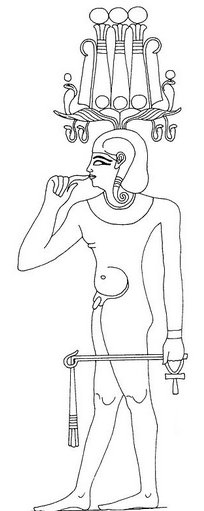
... There is a further
motivation of the same in the
kava taken immediately after
the chief's by the herald, a
representative of the land. This
drinking is 'to kick', rabeta,
the chief's kava.
Raberabe, the same
reduplicated version, means 'a
sickness', the result of kicking
accidently against a 'drau-ni-kau'...
The herald here takes the
effects on himself:
drau-ni-kau is the common
name for 'sorcery' ...
| MAY 20 (140) |
21 |
22 |
23 (*63) |
24 (144 = 12 * 12) |
 |
 |
 |
 |
 |
| Ga3-1 (60) |
Ga3-2 (aaa) |
Ga3-3 |
Ga3-4 (= Ga3-22 - 18) |
Ga3-5 |
| AL TARF (The End) = β Cancri (124.3)
RAS ALGETHI (α Herculis)
|
χ Cancri (125.2), BRIGHT FIRE = λ Cancri (125.4)
*84 = *125.4 - *41.4 |
AVIOR = ε Carinae (126.4), φ Cancri (126.8)
*85 = *126.4 - *41.4 |
ο Ursa Majoris (127.4)
*86 = *127.4 - *41.4 |
Pushya-8 (Nourisher)
υ Cancri (128.1), θ Cancri (128.2) |
| July 23 (204) |
24 (*125) |
25 |
26 |
27 (208) |
| °July 19 (200) |
20 (*121) |
21 |
22 / 7 |
23 (204) |
| 26 (177 = 6 * 29˝) |
'June 27 |
28 |
29 (*100) |
Sirius |
| "June 12 |
13 (*84) |
14 (165 + 365) |
Te Maro 15 (18 * 29˝) |
16 |
| CLOSE TO THE FULL MOON |
| NOV 19 |
20 |
21 (325) |
23 (*246 = 6 * 41) |
23 |
| GREDI = α Capricorni (307.2), σ Capricorni (307.5), ALSHAT (The Sheep) = ν Capricorni (307.9) |
Al Sa’d al Dhabih-20 (Lucky One of the Slaughterers) / Ox / Herd Boy-9 (Buffalo)
DABIH = β Capricorni (308.0), κ Sagittarii (308.1), SADIR (Hen's Breast) = γ Cygni (308.4), PEACOCK = α Pavonis (308.7) |
KHUFU
MINTAKA (δ Orionis)
OKUL = π Capricorni (309.6), BOS = ρ Capricorni (309.9)
ARNEB (α Leporis)
|
KHAFRE
ALNILAM (ε Orionis)
ο Capricorni (310.2), θ Cephei (310.5)
HEKA (λ Orionis)
|
MENKAURE
ALNILAK (ζ Orionis)
ROTTEN MELON = ε Delphini, φ Pavonis (311.2), η Delphini (311.4), ζ Delphini, ρ Pavonis (311.7)
PHAKT (α Columbae)
|
| Jan 22 |
23 |
24 (*309) |
25 (390) |
26 |
| °Jan 18 (384) |
19 |
20 |
21 (*306) |
22 |
| 'Dec 26 (360) |
27 |
28 |
29 |
30 (*284) |
| "Dec 12 |
Ko Koró 13 (Lucia) |
14 (348 = 366 - 18) |
15 |
16 (*270) |
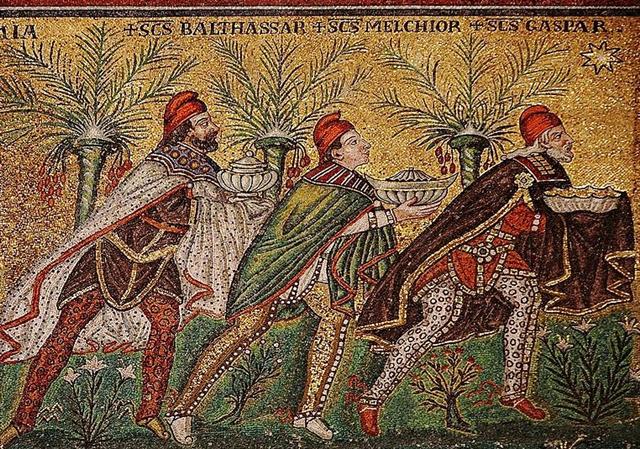 ... Seamen have called it [Mintaka] the Golden Yard-arm; tradesmen, the L, or Ell, the Ell and Yard, the Yard-stick, and the Yard-wand, as occupying 3° between the outer stars, - the Elwand of Gavin Douglas; Catholics, Our Lady's Wand; and the husbandmen of France and along the Rhine, Râteau, the Rake. In upper Germany it has been the Three Mowers; and it is often the Magi, the Three Kings, the Three Marys, or simply the Three Stars ... |
Whenever they had observed the culmination of the stars in Orion's Belt at 21h it would have been known that the Sun was at the other side of the sky, viz. in the λ (Cancer) constellation - at the Gate of Cancer, the place of rebirth.
At the time of Bharani the day 18 * 29˝ = 531 (He Maro 15) - when Makoi surveyed the crater of Rano Kau - was at the other side of the sky compared to where the string of pearls (Alnilam) culminated.
... Makoi got up and began to familiarize himself with the (new) land. (This took place) on the fifteenth day of the month of June ('Maro'). He went toward the sheer face of the rocks (titi o te opata), was astonished (aaa), came up to the middle (of the outer rim of the crater), and stood at the very edge. He looked down and saw the 'Pu Mahore of Hau Maka' (on the coast) and said, 'There it is, the hole of the mahore fish of Hau Maka!' He turned his face and looked toward the back (i.e., in the direction of the crater). No sooner had he seen how the dark abyss opened up (below him), when a fragrant breeze came drifting by. Again Makoi said, 'This is the dark abyss of Hau Maka'. He turned around, walked on in utter amazement, and arrived at the house. He spoke to Ira, 'Hey you, my friends! How forgetful we (truly) are. This place is adequate (? tau or 'beautiful'), the dark abyss lies there peacefully!' Ira replied, 'And what should that remind us of up here?' All arose and climbed up. They went on and arrived; they all had a good look (at the inside of the crater). They returned home and sat down. Night fell, and they went to sleep ...
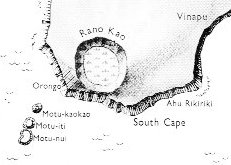
|

.jpg)














